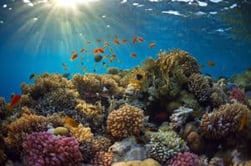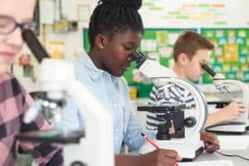Heat Transfer and Thermal Equilibrium Inquiry Lab
Middle School Inquiry Lab on Heat Transfer and Thermal Equilibrium
In this lab students will observe how temperatures change over time and eventually come to equilibrium.
Each inquiry lab will contain an essential question that will drive the lesson and make students think. For this lesson, the essential question is:
- How can time affect the temperature of water?
BACKGROUND INFORMATION AND MATERIALS LIST:
Students will begin the lab by reading the essential question and background information. This can be done individually, as lab groups, or as a whole class. If you consider lab groups, you also might include some type of whole class formative checks before digging into the lab.

Materials List:
- 3 small beakers
- 3 thermometers
- 50 mL graduated cylinder or beaker
- 50 mL of ice
- 50 mL of room temperature water
- 50 mL hot water
- stopwatch
- colored pencils
PROCEDURE:
Plan for this lab to take up the whole class period, but also while students wait in five-minute intervals, you might want to assign a co-assignment that they can work on while they wait. Students will take temperature reading from three different cups of water, one iced, one room temperature, and one hot. During the 20-minute time period for this lab, students will take readings every 5 minutes.
Once students have documented their readings on their data table, they will create a line graph showing their results. Students will have to use three different colors, each representing a specific cup’s temperature.
CHECK FOR UNDERSTANDING:
At this point in the lab, students will be checked for understanding by answering questions about their findings. Here are a few that come with the lab:
- What is the independent variable that you can control?
- What is the dependent variable that is affected by the independent variable?
- What is the control?
- List everything that is being held constant.
- Describe a temperature change on your graph.
- Based on your trend line, predict when each cup will reach thermal equilibrium.
CONCLUSION
Students will go back to the essential question and write a CER (Claim, Evidence, Reasoning) to conclude the lab. Once completed, students will reflect back on their learning by answering the following questions:
- Describe the energy transfer that occurred as the cold water increased in temperature.
- Describe the energy transfer that occurred as the hot water decreased in temperature.
- Describe a real-life example where thermal equilibrium is useful.
MODIFIED AND INDEPENDENT INQUIRY VERSIONS
All of the Kesler Science inquiry labs come with three different modification levels. Each lab is differentiated using the icons below.
STANDARDS ALIGNMENT
TEKS: 6.9B – Verify through investigations that thermal energy moves in a predictable pattern from warmer to cooler until all the substances attain the same temperature, such as an ice cube melting.
NGSS: MS-PS1-4 – Develop a model that predicts and describes changes in particle motion, temperature, and state of a pure substance when thermal energy is added or removed.

Download Over $100 in FREE Resources
For Middle School Science
Simply create a login below and gain immediate access to a selection of our Kesler Science product line worth $100 - for FREE. There's a full version of every product type! You'll also join tens of thousands of middle school science teachers who receive timely tips and strategies straight to their inbox.





